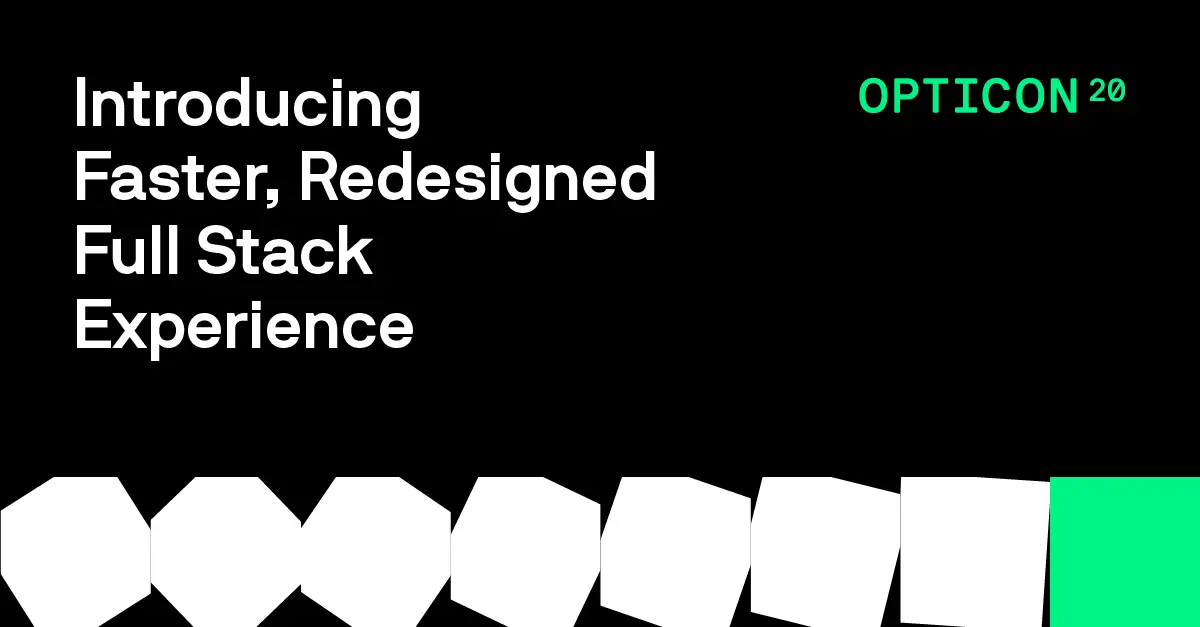New in Full Stack: Simpler, Unified progressive delivery and experimentation

Robin Pam

The highlights:
- The new Decide API replaces 9 APIs with one, single API controlling all feature flag and experiment decisions.
- A new interface for Full Stack unifies the workflows for feature flagging and experimentation, enabling teams to easily transition features from flags to experiments and back, at any point in the feature delivery lifecycle.
- Feature monitoring is coming soon to give you more insight into how feature flags are being used in your product
This year at Opticon, we’re announcing several new enhancements to Full Stack to more tightly integrate experimentation and progressive delivery in Optimizely. With a streamlined user interface, new API, and feature flag monitoring, software development teams will be able to safely deploy code and experiment on new features with less work for developers.
When Full Stack first launched four years ago, at Opticon16, we set out to enable any company to experiment the way that technology leaders like Google and Amazon do: embedded deep within their technology stack and as a routine step in their software development process. Our goal was to democratize the software experimentation practice and make it available to anyone.
We have always been guided by customer-centric product development. At the time, server-side experimentation was our number one customer request, and in the years since, Full Stack has been adopted by some of the some of the brightest rising stars in tech, and the biggest names in business.
Listening to our customers these past four years, we’ve heard over and over that experimentation and feature flagging are coming together in what we now call progressive delivery: the practice of releasing a feature behind a flag, and then rolling it out and experimenting on it to determine the best version for all users. With these new updates to Full Stack, we are continuing to unify feature flagging and experimentation so that product and engineering teams can deliver better products to their customers.
Progressive delivery and experimentation in one simple workflow

When practicing progressive delivery and experimentation, orchestrating experiments and flags from a dashboard can be challenging. Product managers, analysts, engineers, and even other business stakeholders all need one place to see which features are live for which users, which flags and experiments are running, or even the ability to toggle features on or off or transition flags to experiments.
With Full Stack’s new design, your team can create and manage feature flags, and set up experiments on those flags, within one user interface. You can progress from a toggle, used to silently launch new code, to an experiment, used to compare variations of a feature, to a gradual rollout, used to launch your winning variation to the right users at the right time — all from the convenience of a single view that guides you from one step in the software development lifecycle to the next.
By uniting feature flags and experiments in a single progressive delivery and experimentation workflow, all flags become opportunities to experiment, and all experiments benefit from the safeguards flagging provides.
The new interface will begin rolling out for new projects later this year.
One API for flags and experiments
Implementing progressive delivery and experimentation should be easy for your engineering team, but often these are two separate systems. And for years, with Full Stack, it’s taken more APIs than necessary to implement both flags and experiments. We heard from customers that they wanted a simpler, unified approach to implementing Full Stack.
Our answer is the Decide API, a new API to unify the implementation of progressive delivery and experimentation. Decide replaces nine APIs — three specific to experiments, and six specific to flags — with one, simpler and more powerful API. And this one API does everything an engineer might need. It gives you all the information you need about the configuration of a given flag, in one service.
These changes achieve two goals: (1) they reduce the complexity of our SDKs, making them easier for engineers to adopt; (2) they address discrepancies between experiments and flags, to ensure feature parity regardless of the use case you’re pursuing.
For most businesses, developer time is among your scarcest and most expensive resources. By making your developers’ lives easier, Decide allows you to focus on the business goals that matter.
Feature flag monitoring for real-time insight
When launching a new feature or releasing new code, you often want to know the answer to simple questions: How many people are using it? Is it implemented correctly? What configuration does a user see for this feature?
Now, with feature flag monitoring in Full Stack, developers and PMs will get answers to these questions quickly. Flag monitoring provides real-time analytics about which features and experiences your users are accessing which in turn enables youto make crucial, time-saving decisions. Should a new flag be exposed to more users? Or, is an old flag no longer receiving traffic and ready to be removed?
Flag data will also be available for export and to integrate with external platforms, such as Snowflake or DataDog.
All of these changes will begin rolling out in Full Stack later this year. Sign up for a free Rollouts account to get started with Full Stack today!
